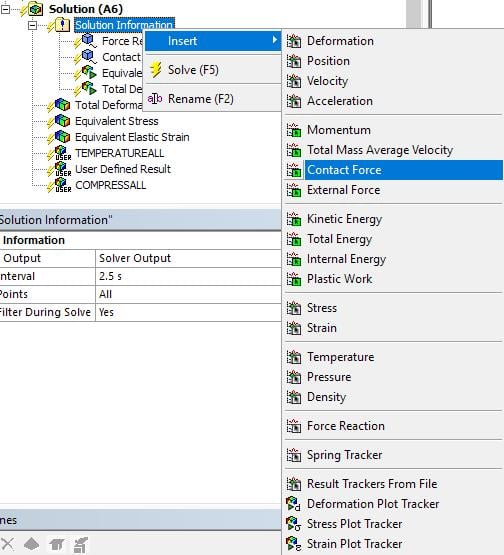-
-
September 9, 2018 at 5:55 pm
-
September 9, 2018 at 6:38 pm
Sandeep Medikonda
Ansys EmployeeHi Ulvi,
Please see this post from another discussion that you might find helpful.
The mass of the part is indirectly derived from the density we specify for the material and can be queried by looking at the information for the selected body.
Regards,
Sandeep
-
September 9, 2018 at 7:06 pm
Ulvi
SubscriberThanks. I helps.
Some of the Ansys environments allow defining point/distributed mass such as static mechanical. Is there any similar way in explicit dynamics?
How do I bring contact force to interface? I think more accurate question would be, what is the expression for contact force in results dialog box? -
September 9, 2018 at 7:22 pm
peteroznewman
SubscriberUlvi,
In this simulation of crashing a car frame into a wall, the wall was held fixed by a joint, and the joint reaction force was plotted to show the impact force.
In order to represent the non-structural mass of the car, the density of steel was increased to increase the weight of the car, but large localized masses like the engine (or batteries for an electric car), they can be represented as a point mass that is supported by selected faces or edges.
Regards,
Peter
-
September 9, 2018 at 11:05 pm
Ulvi
SubscriberPeter, thanks for prompt reply as always.
Does it mean that Ansys can not visualise contact force although it asks whether I need it or not in output controls dialog box?
In my case, I'm checking collision of ship bow to tubular member. Ultimate goal is to compare static means of analysis with dynamic case. Now, if I replace the impacted part (tubular section) I will no longer imitate real case. Hence, I can not do that, plus I am running Ansys 17.2
Do you think it might be somehow possible without defining joints? Should be a way of visualising it
-
September 10, 2018 at 4:06 am
Sandeep Medikonda
Ansys EmployeeUlvi,
As far as I know, you can visualize the contact force as a history output, you just right click on the Solution Information and insert it:
In that image, you can also see that I inserted a force reaction for a boundary condition. I can't confirm if this can be done in 17.2, but I tested this in 19.1.
Also, just FYI, you can insert the following tools into the solution information:
Regards,
Sandeep
-
September 10, 2018 at 11:32 am
peteroznewman
SubscriberUlvi,
As Sandeep shows, you can insert a Reaction Force on a Fixed Support. I don't think Joints are even supported in 17.2, are they? I still have 17.2 installed, so if you want to attach an archive, I can have a closer look.
Try inserting Contact Force. You might find that there are no results, as you had to have requested contact or force results in the Output selection before you ran the simulation.
There is another way to get the total force in your model, since the fairly rigid ship is moving and is much stiffer than the stationary tube. You can plot the directional acceleration of the ship, then use F = ma where m is the mass of the ship.
Regards,
Peter
-
September 16, 2018 at 9:14 pm
Ulvi
SubscriberThanks Peter, I think this solves my case
-
- The topic ‘How to figure out impact force in Explicit Dynamic Analysis’ is closed to new replies.



-
3572
-
1188
-
1076
-
1063
-
952

© 2025 Copyright ANSYS, Inc. All rights reserved.












